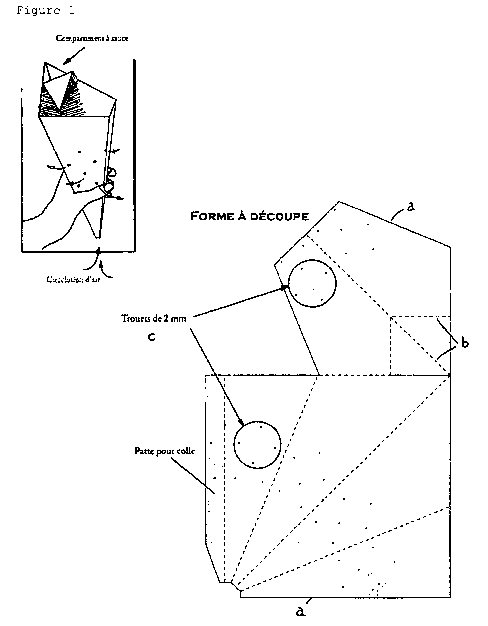Some of the information on this Web page has been provided by external sources. The Government of Canada is not responsible for the accuracy, reliability or currency of the information supplied by external sources. Users wishing to rely upon this information should consult directly with the source of the information. Content provided by external sources is not subject to official languages, privacy and accessibility requirements.
Any discrepancies in the text and image of the Claims and Abstract are due to differing posting times. Text of the Claims and Abstract are posted:
| (12) Patent Application: | (11) CA 2812147 |
|---|---|
| (54) English Title: | CONE FOR CHIPS |
| (54) French Title: | CORNET DE FRITES |
| Status: | Deemed Abandoned and Beyond the Period of Reinstatement - Pending Response to Notice of Disregarded Communication |
| (51) International Patent Classification (IPC): |
|
|---|---|
| (72) Inventors : |
|
| (73) Owners : |
|
| (71) Applicants : |
|
| (74) Agent: | MARKS & CLERK |
| (74) Associate agent: | |
| (45) Issued: | |
| (86) PCT Filing Date: | 2011-09-14 |
| (87) Open to Public Inspection: | 2012-03-22 |
| Availability of licence: | N/A |
| Dedicated to the Public: | N/A |
| (25) Language of filing: | English |
| Patent Cooperation Treaty (PCT): | Yes |
|---|---|
| (86) PCT Filing Number: | PCT/EP2011/065904 |
| (87) International Publication Number: | WO 2012035043 |
| (85) National Entry: | 2013-03-13 |
| (30) Application Priority Data: | ||||||
|---|---|---|---|---|---|---|
|
The present invention generally relates to a French fry cone. The model presented here includes a small opening at the base of the cone, and a series of small holes in the middle of the four surfaces. The various openings enable the circulation of air. The circulation of air prevents the formation of water vapor due to the heat of the French fries, keeps the French fries crispy, and enables the cone to remain rigid throughout the use thereof. In one embodiment, the cone has a compartment which is located at the inner top thereof and which is built therein, and which can be unfolded receive sauce.
La présente invention concerne généralement un cornet de frites. Le modèle présenté ici propose, à la base du cornet, une petite ouverture et au milieu des quatre faces, une série de trouets. Ces diverses ouvertures permettent une circulation d'air. Celle-ci empêche la formation de vapeur produite par la chaleur des frites, garde les frites bien croustillantes et permet au cornet de rester bien rigide tout au long de son utilisation. Dans une réalisation, le cornet à un compartiment situé au sommet intérieur du cornet et intégré dans celui-ci, peut être déplié afin de recevoir la sauce.
Note: Claims are shown in the official language in which they were submitted.
Note: Descriptions are shown in the official language in which they were submitted.

2024-08-01:As part of the Next Generation Patents (NGP) transition, the Canadian Patents Database (CPD) now contains a more detailed Event History, which replicates the Event Log of our new back-office solution.
Please note that "Inactive:" events refers to events no longer in use in our new back-office solution.
For a clearer understanding of the status of the application/patent presented on this page, the site Disclaimer , as well as the definitions for Patent , Event History , Maintenance Fee and Payment History should be consulted.
| Description | Date |
|---|---|
| Inactive: IPC expired | 2017-01-01 |
| Application Not Reinstated by Deadline | 2015-09-15 |
| Time Limit for Reversal Expired | 2015-09-15 |
| Deemed Abandoned - Failure to Respond to Maintenance Fee Notice | 2014-09-15 |
| Inactive: Cover page published | 2013-06-07 |
| Inactive: Notice - National entry - No RFE | 2013-05-27 |
| Inactive: IPC assigned | 2013-04-23 |
| Inactive: Applicant deleted | 2013-04-23 |
| Inactive: IPC assigned | 2013-04-23 |
| Application Received - PCT | 2013-04-23 |
| Inactive: First IPC assigned | 2013-04-23 |
| Inactive: IPC assigned | 2013-04-23 |
| Inactive: IPC assigned | 2013-04-23 |
| Inactive: IPC assigned | 2013-04-23 |
| National Entry Requirements Determined Compliant | 2013-03-13 |
| Application Published (Open to Public Inspection) | 2012-03-22 |
| Abandonment Date | Reason | Reinstatement Date |
|---|---|---|
| 2014-09-15 |
The last payment was received on 2013-03-13
Note : If the full payment has not been received on or before the date indicated, a further fee may be required which may be one of the following
Please refer to the CIPO Patent Fees web page to see all current fee amounts.
| Fee Type | Anniversary Year | Due Date | Paid Date |
|---|---|---|---|
| MF (application, 2nd anniv.) - standard | 02 | 2013-09-16 | 2013-03-13 |
| Basic national fee - standard | 2013-03-13 |
Note: Records showing the ownership history in alphabetical order.
| Current Owners on Record |
|---|
| LUC SEGERS |
| ANTONIO MALANDRINI |
| DERWA, LOUIS |
| Past Owners on Record |
|---|
| None |